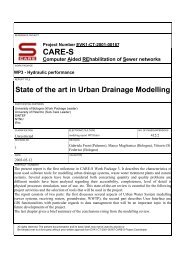Modeling
R184_CHI_Rules
R184_CHI_Rules
You also want an ePaper? Increase the reach of your titles
YUMPU automatically turns print PDFs into web optimized ePapers that Google loves.
Generation of Long-term Rain Input 93<br />
There is, however, currently no model that can directly disaggregate daily<br />
rainfall into 1-15 minute rainfall. Also, available disaggregation models cannot<br />
extend the length of the rainfall data, they only artificially enhance the time<br />
resolution of the data.<br />
Most stochastic models attempt to model occurrence and duration of both<br />
wet and dry events (intermittency) coupled with another algorithm to determine<br />
precipitation amounts for the wet events. These increasingly complex models do<br />
not, however, provide any explanations relating to processes that drive the<br />
rainfall phenomenon (Yevjevich, 1991). Rainfall is a complex atmospheric<br />
process that is affected by incident solar radiation, sunspot activity, lunar orbits,<br />
the El Niño-Southern Oscillation (ENSO) phenomenon, wind circulation<br />
patterns, etc. Models based on probabilistic outcomes and parameter fitting<br />
without any correlation to physical processes are insufficient and dishonest<br />
(Klemeš, 1986).<br />
Within the stochastic modeling approach, there is interest in developing a<br />
general theory to characterize the internal structure of rainfall. By examining the<br />
internal structure of rainfall, hydrologists attempt to describe the link between<br />
the observed rainfall and the mechanisms responsible for its occurrence.<br />
Estimating the properties of the underlying processes that lead to an observed<br />
series is termed TS analysis (Bras and Rodriguez-Iturbe, 1985). TS analysis<br />
models of rainfall attempt to analyze trends, periodicities, and frequencies in<br />
order to describe, explain, and simulate rainfall rates. TS analysis is also being<br />
used to correlate climate patterns such as between rainfall and other physical<br />
phenomena.<br />
Wavelet analysis is a new tool that can be used for time-analysis of multifrequency,<br />
multi-scale signals that may be non-stationary or non-sinusoidal in<br />
structure (Bradshaw & McIntosh, 1994). Wavelets and wavelet transforms offer<br />
many advantages over traditional Fourier transforms, which are inadequate for<br />
analyzing non-stationary, variable, and intermittent data such as rainfall.<br />
6.2 Review of rainfall modeling and analysis techniques<br />
There are many rainfall model and analysis tools, each utilizing different<br />
temporal and spatial scales (Berndtsson and Niemczynowicz, 1988). For the<br />
sake of brevity, only a few model types from each approach are briefly<br />
mentioned here.<br />
The common origins of all rainfall models can be traced back to the late 19 th<br />
century where engineers required design flows for hydraulic structures such as<br />
sewers, open channels, and reservoir systems (Todini, 1988). The main focus<br />
for urban hydrologists has been to determine the return period, or return<br />
frequency, of extreme hydrologic events (Niemczynowicz, 1994). I-D-F curves<br />
were developed as a packaged representation of recorded rainfall data for a<br />
geographic region. These I-D-F curves provided average rainfall intensities as a




